Party lines: A look at the major players in a fragmented political scene
In 1990 the Peruvian electorate veered away from well-established political parties and instead chose the relatively unknown Alberto Fujimori, campaigning under the banner of his newly formed Cambio 90, to be president. Now, more than a decade after democracy has been restored following the fall of Fujimori’s authoritarian regime, they are still in the process of rebuilding. Progress has been slow and inconsistent, with major political parties having varied degrees of success. The fractured nature of the party system has encouraged the establishment of coalitions and alliances for elections, and of parliamentary majorities once in power.
PERU WINS: Peru Wins, the party of President Ollanta Humala, falls on the left side of the political spectrum. It was formed specifically for the 2011 election as a coalition of various parties, including the Peruvian Nationalist Party and nationalist members of the Union for Peru party who had united behind Humala in the 2006 elections. The Socialist Party, Peruvian Communist Party and Revolutionary Socialist Party also joined.
Aside from winning the 2011 presidential runoff election, Peru Wins was successful in Congress as well, winning 25.3% of the popular vote and 47 of 130 congressional seats – the largest share among the parties. The party has formed a majority coalition with the Peru Possible (PP) Alliance, the centrist group of former President Alejandro Toledo. It also won 27% of the vote in the election of Peru’s five members of the Andean Parliament, handing the party two representatives.
FORCE 2011: Led by Keiko Fujimori, daughter of the controversial former president, Force 2011 is considered a right-wing conservative organisation. Formed for the general election, the party and its presidential candidate received 23.6% of the votes in the general election before losing in the presidential runoff with 48.7% of the vote. The party also finished second in the congressional elections, picking up 37 seats in the Congress and one seat in the Andean Parliament.
PERU POSSIBLE: Founded by former President Toledo in 1994, PP is one of many centrist political organisations in Peru. After succeeding in replacing Alberto Fujimori in 2000, the PP pulled its candidate out of the 2006 elections before Toledo decided to run for a second presidential term in 2011 (the Peruvian constitution prevents consecutive presidential terms). Toledo finished the election in fourth place, having won 15.6% of the votes. However, PP came third in congressional elections, winning 21 seats.
ALLIANCE FOR GREAT CHANGE: The Alliance for Great Change (PPK) was also formed for the 2011 general election to prop up non-partisan presidential candidate Pedro Pablo Kuczynski. The PPK gained support from the Christian People’s Party, the Alliance for Progress, the National Restoration Party and the Peruvian Humanist Party. In the congressional elections the PPK won 12 seats, with 14.4% of the popular vote, and one seat in the Andean Parliament, while Kuczynski won 18.5% of the presidential vote.
NATIONAL SOLIDARITY ALLIANCE: Also formed for the 2011 general election, the National Solidarity Alliance is led by former presidential candidate and former Mayor of Lima Luis Castañeda. Parties in the coalition include the eponymous National Solidarity Party, some of the core members of the Union for Peru, Cambio 90 (a successor to Fujimori’s former party), Always Together and Everyone for Peru. The alliance won 10.2% of the vote in the 2011 congressional election, giving it nine seats. Castañeda’s presidential campaign began quite brightly, but he slid into fifth place, with 9.8% of the votes in the general election.
APRA-PERUVIAN APRISTA PARTY: The American Popular Revolutionary Alliance (APRA) is Peru’s oldest and traditionally most institutionalised political party. Founded in 1924 by political activist and lawyer Víctor Raúl Haya de la Torre, APRA is the party of former two-term President Alan García. Mercedes Rosalba Aráoz Ferná ndez, the party’s candidate in the 2011 presidential elections, withdrew her candidacy amid a congressional corruption scandal involving members of the party. APRA won four congressional seats in 2011.
You have reached the limit of premium articles you can view for free.
Choose from the options below to purchase print or digital editions of our Reports. You can also purchase a website subscription giving you unlimited access to all of our Reports online for 12 months.
If you have already purchased this Report or have a website subscription, please login to continue.

